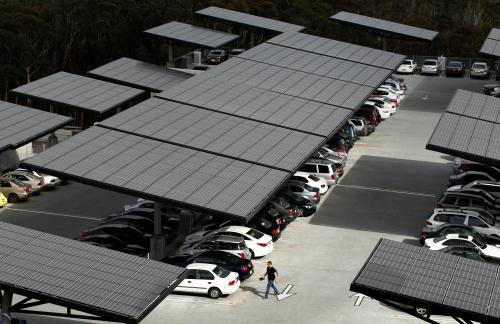In my paper, “The Net Benefits of Low and No-Carbon Electrical Technologies,” (2014 Global Economy and Development Working Paper) I estimated the net benefits of five different electricity technologies: wind, solar, hydro, nuclear, and natural gas combined cycle. Natural gas combined cycle generated the most net benefits under a wide range of assumptions, despite a penalty of $50 per metric ton of CO2 emissions. Wind and solar technologies consistently ranked fourth and fifth among the five technologies.
Combined cycle natural gas plants generated more net benefits because the capital costs per megawatt of wind and solar were much higher and the capacity factors of wind and solar were much lower than those of natural gas. Combined cycle natural gas plants could be relied on to produce at full power up to 90 percent of the time. Put another way, they were able to achieve a capacity factor of up to 90 percent. By contrast, wind and solar projects typically utilized much less than half of their full capacity – in other words, they typically had capacity factors much less than 50 percent.
However, much has changed over the past three years. The prices of oil and natural gas have plummeted, while both the cost and the performance of wind and solar technologies have continued to improve. How have these changes affected the analysis?
The capital cost of U.S. solar projects has fallen about 25 percent over the past three years, from about $3,600 per kilowatt in 2013 to about $2,700 in 2015. The 2015 weighted average capacity factor for solar has increased by about 10 percent for projects completed in 2014 compared to 2012. (Lawrence Berkeley National Laboratory, Utility-Scale Solar 2015, August 2016, p. 12 and p. 25).
The capital cost of wind projects has remained around $1,700 per kilowatt over the past three years. Capacity factors, however, have increased dramatically. The 2015 weighted average capacity factor for projects completed in 2014 was about 41.2 percent, compared to 33 percent for projects completed in 2012 (U.S. Department of Energy, Wind Technology and Market Report 2015, August 2016, pp. 42 and 53).
The latest available data for capital costs, capacity factors, and fuel prices have been incorporated into an updated version of the model used in my original working paper. The new findings are shown below:

Key assumptions used are:
- A new low-carbon plant replaces a coal plant off-peak and a simple cycle gas turbine on-peak.
- The price of natural gas is the 2015 average price paid by electric utilities.
- The cost of carbon is $50 per metric ton of CO2.
- The cost of capital is 7.5 percent.
- Emissions from a new gas combined cycle plant are grossed up to account for fugitive emissions resulting from the production, transportation and distribution of natural gas.
- Other costs include balancing costs for wind and solar and insurance and decommissioning costs for nuclear.
Natural gas combined cycle remains number one in terms of net benefits. However, because of improvements in capacity factors since 2014, wind rises from fourth to second, just behind natural gas combined cycle and ahead of nuclear, solar, and hydroelectric. Solar ranks well behind wind because its capital costs are substantially higher and its capacity factors are much lower.
If you care about climate change, natural gas combined cycle plants remain the most cost-effective way to reduce CO2 emissions costs at the present time.
The results are sensitive to the price of natural gas. For example, at a price for natural gas of $10 per million btu—more than three times the current price—wind ranks first. The results are also sensitive to the price of carbon. For example, if the cost of carbon dioxide is $150 per metric ton of CO2 or higher, nuclear power ranks first. For those interested in examining the model and its sensitivities in more detail, click here for the spreadsheet used in the analysis.
In conclusion, if you care about climate change, natural gas combined cycle plants remain the most cost-effective way to reduce CO2 emissions costs at the present time. However, at higher prices for natural gas and higher costs of CO2 emissions, wind and nuclear become more attractive alternatives.
The Brookings Institution is committed to quality, independence, and impact.
We are supported by a diverse array of funders. In line with our values and policies, each Brookings publication represents the sole views of its author(s).









Commentary
New results on the net benefits of low-carbon electricity technologies
October 17, 2016